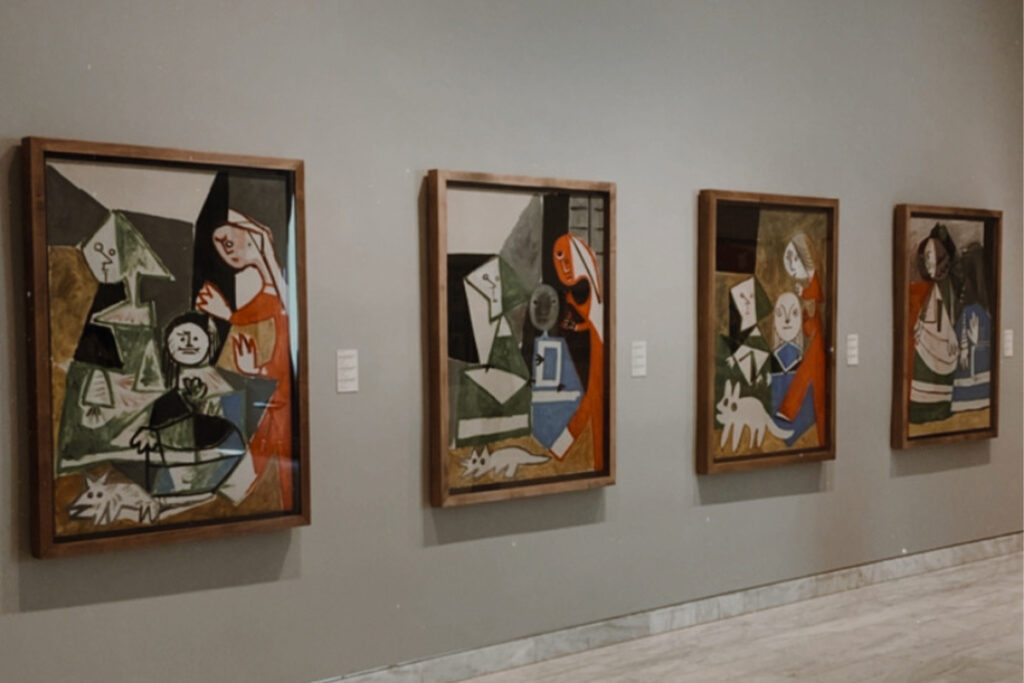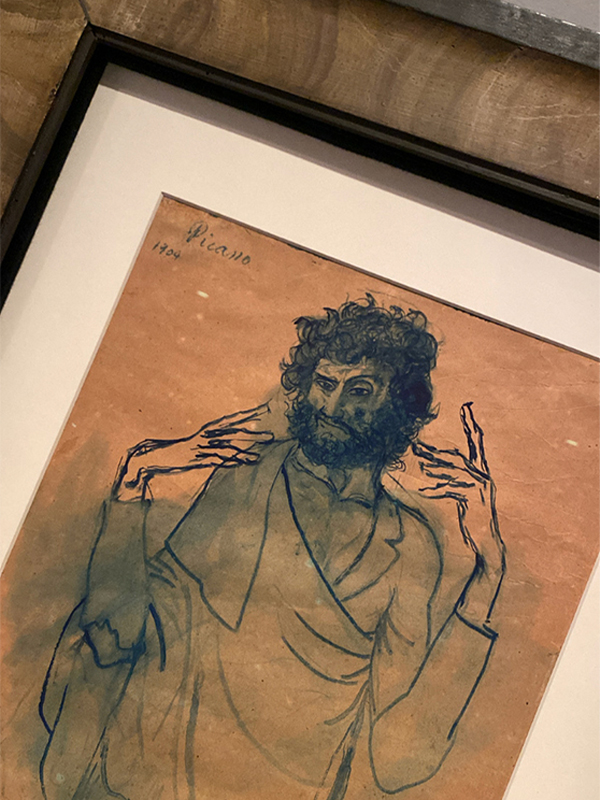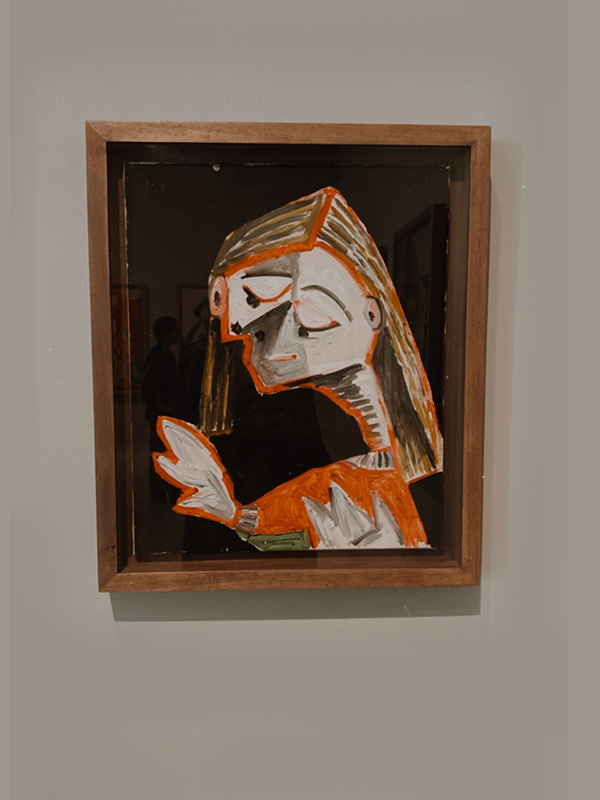Are you ready to unleash your inner art lover and dive into the fascinating world of Pablo Picasso? The Picasso Museum in Barcelona awaits you, offering a unique journey through the life and works of this iconic artist.
In this blog post, we will guide you through the museum’s captivating history, must-see pieces, and essential visitor information, ensuring that your visit to this artistic treasure trove is nothing short of extraordinary.
- Explore the incredible life and works of Pablo Picasso at Barcelona’s Museum Picasso, one of the three largest collections in the world!
- Take a chronological journey through five beautiful palaces, witness must-see pieces such as “Barcelona Rooftops” & explore fascinating temporary exhibitions.
- Discover La Llotja, Els Quatre Gats café & more to gain an appreciation for how his time in Barcelona shaped his creative process!
Discovering the Picasso Museum
Imagine stepping into a world where art and history come to life, showcasing the incredible journey of a young artist who would go on to become one of the most celebrated painters of all time. That’s precisely what awaits you at the Picasso Museum Barcelona, a haven for art enthusiasts and history buffs alike. Housing one of the three largest collections of Picasso’s work in the world, this museum dedicated to the life and works of Pablo Picasso is an absolute must-visit destination when in the heart of Catalonia’s captivating city.
Nestled within the charming La Ribera district, the museum opened its doors in 1963, following the collaborative efforts of Picasso’s friend and personal secretary, Jaume Sabartés, the city of Barcelona, and the artist himself. The Museum Picasso is situated on the historic Carrer de Montcada, a street renowned for its medieval architecture and five adjoining Gothic palaces, which together form the perfect backdrop for Picasso’s stunning works.
The Birth of the Museum Picasso
The founding of the Museum Picasso is a tale of friendship, passion, and a shared love for art. The museum’s creation was proposed by Jaume Sabartés, who envisioned a space in Barcelona dedicated to the young Picasso’s work. With the city’s support and the artist’s personal involvement, the museum opened its doors in 1963, displaying an extensive collection of over 4,200 works, primarily from Picasso’s formative years between 1895 and 1904.
Visitors have the opportunity to admire some of Picasso’s earliest significant works, such as “The First Communion” (1896) and “Science and Charity” (1897). These early pieces showcase his incredible talent and the beginning of his artistic journey, with “First Communion” marking his impressive debut into the public art world. The museum’s permanent collection also includes the complete series “Las Meninas,” a reinterpretation of Diego Velázquez’s famous painting, further highlighting Picasso’s ingenuity and artistic prowess.
The Museum’s Location: Carrer de Montcada
The Museum Picasso’s awe-inspiring location on Carrer de Montcada is a treasure in itself. This historic street, built in the 12th century and declared an art historical heritage in 1947, is a testament to the rich history of Barcelona. The museum is housed within five stunning Gothic palaces:
- the Palace Aguilar
- the Palau del Baró de Castellet
- the Palau Meca
- the Casa Mauri
- the Palau Finestres
Each adjoining medieval palaces adds an air of grandeur and elegance to the museum, creating an unforgettable experience for visitors.

Venturing into the museum’s surroundings is a journey on its own, as the La Ribera neighborhood is home to a wealth of cultural and architectural gems. Stroll along Carrer de Montcada, and you’ll find yourself immersed in the captivating atmosphere of medieval Barcelona, with the street ending at the picturesque Plaça del Born at Santa Maria del Mar. This enchanting setting is the perfect backdrop for appreciating the artistic genius of Pablo Picasso.
Having a plan when visiting the museum is pivotal to comprehending the evolution of Picasso’s art. This section offers guidance on how to navigate the Picasso Museum, including a suggested chronological tour, must-see pieces, and temporary exhibitions that will enhance your experience. Follow these recommendations, and you’ll leave the museum with a newfound appreciation for Picasso’s remarkable artistic journey.
A Chronological Tour
Embarking on a chronological tour of the Museum Picasso is a fantastic way to observe the maturation of the artist’s work. The museum’s collection is arranged chronologically across five stunning adjoining palaces, allowing visitors to witness the transformation of Picasso’s style over time. Begin your tour with early works like “First Communion” and “Science and Charity,” and watch as Picasso’s artistic prowess blossoms before your eyes.
As you progress through the museum, you’ll encounter Picasso’s captivating Blue Period, characterized by a melancholic palette reflecting the death of his friend Carlos Casagemas. Moving forward, you’ll witness the artist’s experimentation with various artistic periods, including the vibrant Rose Period, the African-influenced period, and the groundbreaking Cubist movement. By viewing Picasso’s work chronologically, you’ll gain a profound understanding of his evolution as an artist, allowing you to fully appreciate the depth and diversity of his incredible oeuvre.
Highlights and Must-Sees
While every piece in the Museum Picasso is a testament to the artist’s talent, there are certain must-see works that stand out as highlights of the collection. Among these are “Barcelona Rooftops,” a mesmerizing painting that captures the essence of the city, and “Barceloneta Beach,” a vibrant depiction of the bustling beachside locale. Both of these pieces showcase Picasso’s unique ability to evoke the spirit of Barcelona through his art.
Another must-see highlight is Picasso’s reinterpretation of “Las Meninas” by Diego Velázquez, featuring Infanta Margarita Maria. This series of 58 paintings, a prime example of Picasso’s work, showcases the artist’s reinterpretation of the classic work, adding his own unique touch while remaining faithful to the original. As you explore the museum, be sure to take the time to appreciate these exceptional pieces, as they offer a glimpse into the creative genius that is Pablo Picasso and the breadth of Picasso’s works.
Exploring Temporary Exhibitions
In addition to its extensive permanent collection, the Museum Picasso offers a variety of exciting temporary exhibitions that focus on specific themes in Picasso’s work or life. These exhibitions provide an opportunity to delve deeper into the artist’s creative process while offering a fresh perspective on his work. Be sure to check the museum’s calendar before your visit to see which temporary exhibitions are available during your visit.
Past temporary exhibitions at the Museum Picasso have included “Picasso/Barcelona: The Years of Formation (1895-1904),” “Picasso/Dalí, Dalí/Picasso,” and “Picasso and the Exodus: A Journey to Freedom”, to name just a few. These exhibitions not only showcase the breadth of Picasso’s work but also provide valuable context and insight into his life and influences. Don’t miss the opportunity to explore these fascinating exhibitions and gain a deeper understanding of the iconic artist.
Connecting with Picasso’s Barcelona
Picasso’s connection to Barcelona runs deep, with the city playing a pivotal role in shaping Picasso’s life and work. This section unveils the significance of Picasso’s formative years in Barcelona, exploring the artistic beginnings that would ultimately propel him to global renown.
From his time at the prestigious art academy La Llotja to his exhibitions at the famed Els Quatre Gats café, join us as we delve into Picasso’s Barcelona and the creative journey that began within its enchanting streets.
Artistic Beginnings: La Llotja and Els Quatre Gats
Picasso’s journey as an artist began in the bustling city of Barcelona, where he moved with his family in 1895. As a young artist, he studied at the prestigious La Llotja art school, honing his skills and immersing himself in the thriving art scene that would come to define his early career. It was during this time that the young Picasso began exhibiting his work at the iconic Els Quatre Gats café, a hub for the city’s modernist movement and a meeting point for Barcelona’s most influential artists and writers.
These early experiences in Barcelona would leave an indelible mark on Picasso’s work, shaping his artistic approach and providing him with a wealth of inspiration and creative stimulation. As you explore the Museum Picasso, be sure to reflect on the artist’s formative years in the city, as they offer a unique insight into the forces that shaped his extraordinary artistic trajectory.
Picasso’s Creative Process
Throughout his life, Picasso’s creative process was characterized by his inventiveness and willingness to explore new artistic directions. His time in Barcelona played a crucial role in shaping his art, exposing him to the progressive culture and artistic expression that permeated the city. The experiences and influences he encountered in Barcelona can be seen in the thousands of drawings and paintings on display at the Museum Picasso, offering a fascinating window into the artist’s creative journey.
Picasso’s creative process was also heavily influenced by his time at La Llotja and Els Quatre Gats, where he was exposed to a circle of Catalan artists and writers who would inspire and challenge him throughout his career. As you explore the museum, take the time to appreciate the impact that Picasso’s time in Barcelona had on his work, and marvel at the incredible artistic legacy that the city helped to shape.
Essential Visitor Information
Being well-prepared with all necessary information is crucial for maximizing your visit to the Picasso Museum. This section outlines the following details:
- Admission fees
- Discounts
- Comparisons to the Musée Picasso in Paris
- Tips for managing your time effectively.
With this essential information at hand, you’ll be well-equipped to enjoy a smooth and unforgettable visit to the captivating world of Picasso.
Admission Fees and Discounts
Visiting the Museum Picasso is an experience worth every penny, and luckily, the museum offers a range of admission prices and discounts to suit every budget. General admission to the museum is €15 for adults, with a reduced price of €14 when purchasing tickets online. Reduced price tickets are available for €7.50 for university students, people under 25 and over 65, as well as Barcelona library card holders. Take advantage of this special offer and enjoy a cheaper ticket!
To make the most of your visit to Barcelona’s art scene, consider investing in a Barcelona Card or Barcelona Articket discount card, which offer free entry and discounts on multiple art museums throughout the city. Remember, the Museum Picasso offers free admission on the first Sunday of every month, so plan your visit accordingly to take advantage of this fantastic opportunity.
Comparing Museum Picasso in Barcelona and Musée Picasso in Paris
While both the Museum Picasso in Barcelona and the Musée Picasso in Paris showcase the incredible work of Pablo Picasso, each museum offers a unique perspective on the artist’s life and oeuvre. The Museum Picasso in Barcelona focuses primarily on Picasso’s early stages and his relationship with the city, allowing visitors to explore his artistic development within the context of his Catalan roots. The Musée Picasso in Paris, on the other hand, offers a more comprehensive look at Picasso’s career, featuring works from various periods and styles that span his entire life.
Visiting both museums is highly recommended for art enthusiasts, as the unique collections and perspectives offered by each institution provide a well-rounded understanding of Picasso’s artistic journey. From his early works in Barcelona to his groundbreaking Cubist masterpieces in Paris, exploring these museums allows you to delve deep into the heart and soul of Picasso’s incredible legacy.
Making the Most of Your Time
Given the abundance of sights and experiences at the Museum Picasso, planning your visit judiciously is key to optimally utilizing your time. Here are some tips to help you make the most of your visit:
- The average tour length for the museum is around 1.5 hours, but be prepared to spend more time if you wish to fully immerse yourself in the stunning artworks and exhibits on display.
- To avoid the crowds, consider visiting during off-peak hours or earlier in the day.
- Thursdays are a good day to visit as the museum is open until 9:30 PM.
For an even more enriching experience, consider taking a guided tour or participating in one of the museum’s educational programs. These offerings are designed to enhance your understanding of Picasso’s art and provide a deeper appreciation for the artist’s incredible talent.
No matter how you choose to explore the Museum Picasso, you’re sure to leave with a newfound admiration for the genius of Pablo Picasso.
Summary
In conclusion, the Picasso Museum in Barcelona offers a unique and unforgettable journey through the life and works of one of the most celebrated artists in history. From the museum’s captivating history and stunning location to the awe-inspiring collection of Picasso’s early works and temporary exhibitions, there is truly something for everyone at this artistic treasure trove. As you explore the museum and connect with Picasso’s Barcelona, remember that the experience is not just about viewing incredible art, but about immersing yourself in the creative spirit that continues to inspire and captivate art lovers from around the world.
Frequently Asked Questions
Is Barcelona Picasso Museum worth it?
The Picasso Museum in Barcelona is an absolute must for art lovers, housing a huge collection of Pablo Picasso’s work throughout his evolution. Experience the beauty and impact of one of Spain’s greatest artists first hand!
How long does it take to go around the Picasso Museum Barcelona?
Experience the Picasso Museum Barcelona in 90 minutes to 2 hours and immerse yourself in the collections and exhibitions!
How many Picasso museums are there in Barcelona?
The Picasso Museum in Barcelona is a complex of five palaces housing an extensive collection of 4251 works by Pablo Picasso, making it the largest museum dedicated to his works.
What is the most famous painting in Picasso Museum Barcelona?
The most famous painting in Picasso Museum Barcelona is Picasso’s interpretation of Diego Velazquez’s masterpiece “Las Meninas”, which is part of his larger series and is visually abstract.
What is the admission fee for the Museum Picasso in Barcelona?
Come explore the Museum Picasso in Barcelona for a great price – €15 for general admission or even better, €14 when you buy your tickets online. Reduced price tickets are also available for €7.50 for specific groups!
Practical info
It’s best to buy tickets to the Picasso Museum in advance. You will then avoid standing in a long queue and avoid the risk that all tickets have been sold out, which happens very often in the case of this monument.
- Opening hours: Tuesday to Sunday 10 AM to 7:00 PM. On Mondays the museum is closed.
- Address: C/ de Montcada, 15-23, Ciutat Vella, 08003 Barcelona, Spain
- Buy Tickets on GetYourGuide
Picasso Museum on a map
Discover Catalonia
Each region of Spain is divided into provinces. Their names often coincide with the names of their main cities. Catalonia is divided into four provinces, each of which has different tourist attractions and interesting places to offer:| Province | Tourist attractions and interesting places |
| Barcelona | Gothic Quarter Barri Gòtic, La Rambla, Montjuïc, cable railway Telefèric de Montjuïc, Magic Fountains (Font Màgica), La Boqueria, Laberint d’Horta Park, Poble Espanyol, Camp Nou, Torre Agbar, oceanarium in Barcelona, Barcelona Zoo, Tibidabo Amusement Park, Palace of Catalan Music, National Art Museum of Catalonia, Picasso Museum, Catalan Museum of Archaeology, Miniature Park - Catalunya en Miniatura, MACBA Museum of Contemporary Art of Barcelona, Generalitat Palace, Basilica of Our Lady of Mercy (La Mercé), Cathedral of Barcelona, remains of the temple of Augustus, Els Quatre Gats Cafe, Erotic Museum, Santa María del Mar Church, Port Vell, Plaça de Catalunya, Parc de la Ciutadella, Parc de Collserola, Casa Amatller, Palau Güell, Passeig de Gràcia - luxury street in Barcelona, Montserrat Monastery. Barcelona's neighborhoods and districts (El Raval, El Born, Sant Pere, Les Corts). Gaudi's Monuments: Sagrada Familia, Park Güell, Casa Milà, Casa Batlló, Pabellones Güell, Bellesguard, Casa Vicens, Casa Calvet. Popular cities: Barcelona, Torrelles de Llobregat, Hospitalet de Llobregat, Tarrasa, Badalona, Sabadell, Mataró, Santa Coloma de Gramanet, San Cugat del Vallés, Cornellá de Llobregat, San Baudilio de Llobregat, Rubí, Manresa, Villanueva y Geltrú, Viladecans, Casteldefels, El Prat de Llobregat, Granollers, Sardañola del Vallés, Mollet del Vallès, Gavá, Sant Antoni de Vilamajor |
| Girona | Salvador Dali Museum, Museum of Miniatures and Microminiatures Micro Mundi, Sausage Museum. Popular cities: Girona, Figueres, Besalú, Blanes, Lloret de Mar, Tossa de Mar, Olot, Salt, Palafrugell, San Felíu de Guixols, Rosas, Bañolas, Palamós, Santa Coloma de Farnés, Castellón de Ampurias Torroella de Montgrí, La Bisbal del Ampurdán, Ripoll, Castillo de Aro, Calonge, La Escala, Cassá de la Selva, Castellfollit de la Roca |
| Lleida | Popular cities: Lleida, Tárrega, Balaguer, Mollerusa, La Seo de Urgel, Cervera, Solsona, Alcarrás, Guisona, Almacellas |
| Tarragona | Amusement and theme parks: PortAventura. Popular cities: Tarragona, Reus, Vendrell, Tortosa, Cambrils, Salou, Valls, Calafell, Amposta, Vilaseca |





